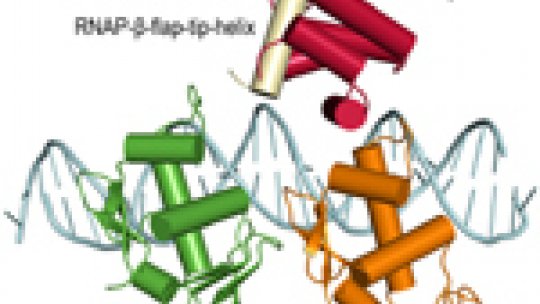Images
Contact

The use of crystallography allows us to 'see' the regulation of gene expression in bacteria.
Proteins are the building blocks that construct and perform most functions in all living beings. One of the keys to understanding life is knowing how genes transmit the information they contain to make proteins. The protein RNA polymerase is essential for the transmission of this information. It binds to specific regions of genes to initiate transcription of DNA into RNA and produce the proteins needed at any one time.
Researchers at IRB Barcelona have used Escherichia coli to study the binding of RNA polymerase to genes that are activated at specific times and require more complex regulation that permanently activated genes in cells. The study, led by Miquel Coll, CSIC researcher professor and Head of the Structural and Computational Biology programme at IRB Barcelona, shows that binding of RNA polymerase to these genes requires other proteins to stabilize the contacts with DNA. These stabilizing proteins are essential to promote transcription of these genes, the first step in the production of proteins.
Using crystals to understand how cells work
In genes that are constantly activated, RNA polymerase needs no intermediaries to recognize specific areas of the DNA, called promoter regions. This is not the case, however, for the genes whose activation depends on the conditions of the cells. In this study, scientists have used structural biology methods to gain insight into how genes called pho regulon are activated when cells need to incorporate phosphate to survive.
By means of crystallographic techniques (forming crystal and then exposing them to X-ray diffraction using the European Synchrotron Radiation Facility, ESRF, located in Grenoble), scientists have obtained a three-dimensional structure of the protein complex necessary for the activation of pho regulon genes. This structure shows that RNA polymerase binds to a second protein, a transcriptional activator called PhoB, which in turn is attached to the DNA in the promoter region. Indirectly, this binding increases the number of contact points between the RNA polymerase and the DNA, stabilizing the complex and facilitating the initiation of transcription. Results also show that RNA polymerase changes its shape after binding to the promoter regions of these genes. " In addition to facilitating the initiation of transcription by recruiting RNA polymerase, the activator PhoB also causes movements in one of the subunits of the polymerase, opening an exit channel for nascent RNA and thereby facilitating transcription", Coll explains.
Crystallography may be a very informative tool for the study of transcription, allowing us to 'see' the position of the atoms and molecules involved in different stages of this process. According to Coll, "the biggest difficulty of these approaches lies in the preparation of the DNA-protein complexes, and their crystallization."
Reference article:
The Structure of a Transcription Activation Sub-Complex Reveals How σ70 is Recruited
to PhoB Promoters
Alexandre G Blanco, Albert Canals, Jordi Bernués, Maria Solà and Miquel Coll
EMBO Journal (doi: 0.1038/emboj.2011.271)
About IRB Barcelona
The Institute for Research in Biomedicine (IRB Barcelona) pursues a society free of disease. To this end, it conducts multidisciplinary research of excellence to cure cancer and other diseases linked to ageing. It establishes technology transfer agreements with the pharmaceutical industry and major hospitals to bring research results closer to society, and organises a range of science outreach activities to engage the public in an open dialogue. IRB Barcelona is an international centre that hosts 400 researchers and more than 30 nationalities. Recognised as a Severo Ochoa Centre of Excellence since 2011, IRB Barcelona is a CERCA centre and member of the Barcelona Institute of Science and Technology (BIST).




